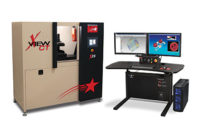New tube technology aids in measurement of oversized components
Quality Magazine's NDT Supplements
• FEBRUARY 2004
• OCTOBER 2003
An X-ray machine has been developed that uses new tube technology for nondestructive testing on oversized components that would otherwise put a strain on smaller machines, including the machine on which this one was based.
The ndt|analyser XXL is the next-generation of large-scale X-ray systems from phoenix|x-ray Systems + Services Inc. (Camarillo, CA). It is based on the company's ndt|analyser, an X-ray system introduced to the market in 2001.
The XXL is about 30% larger than the ndt|analyser, and while larger custom-built units can be can be found in OEM shops, the XXL is one of the largest standard NDT systems on the market. The smaller ndt|analyser unit has a work envelope of 18 inches in the vertical and 24 inches in the horizontal direction. The XXL has a 30-inch vertical and a 24-inch horizontal work area. The new model has a 66-pound capacity with an optional 140-pound capability.
The larger cabinet allows for work on larger assemblies such as the turbine blades of land-based turbo-powered vehicles like those in military tank engines and electrical power generators. Bob Maziuk, NDT sales manager for phoenix|x-ray, says that this is particularly effective in a failure analysis arena when the part is partially built. "If a component that has been assembled is suspected of failing," says Maziuk, "this system will accommodate the whole assembly rather than having to tear it down."
The XXL can be used in applications where components and materials face high stress levels, such as turbine blades in the aerospace industry, where detecting faults at features sizes around 1 micron is critical to the endurance of final products.
New tube technology
The X-ray system is capable of detail detectability as small as 1 micron. And, it can examine as small as a 2-micron focal spot. The focal spot size is critical to the level of defect detectability that can be achieved. The smaller the focal spot, the smaller the size of the indication that can be detected. With a larger focal spot, the detectablity decreases and the overall sensitivity of the system is reduced.
The key to this level of indication detectability and small focal spot size is a stable and reliable X-ray source with tight mechanical tolerances, says Maziuk.
"To achieve a consistent quality level of images and to maintain a high percentage of up time, the stability of the X-ray tube is critical," says Maziuk. He adds that this is the result of a new tube that was designed from the ground up.
The company's new Phoenix Tube features a tube interior that has been polished to provide an ultra-smooth finish. On the internal surface of an X-ray tube, microscopic burrs are created in the manufacturing process. Such burrs are sources for arcing in a high-voltage environment. All tube makers polish the internal surfaces with fine grain grits and Phoenix has implemented a second step that uses a chemical etching process on all internal surfaces to achieve the ultra-smooth surface finish.
In addition, the XXL uses directional tube technology. This technology uses a solid target from which the X-ray energy is reflected. The company had a choice of tube technologies to use. A second type of tube technology, called a transmission target, uses a thin beryllium or aluminum X-ray port window with a 4 to 10 micron thickness of tungsten. The target is positioned perpendicular to the electron beam so that the beam strikes the tungsten on one side of the window and the X-ray beam is transmitted through the other side of the window. The transmission target technology, while good for low-density materials and high-contrast samples requiring geometric magnification levels in excess of 1,500, has a power limitation of 20 watts because of the properties of the tungsten. The directional tube technology, on the other hand, is capable of running 320 watts. The company chose the directional tube technology.
An important feature, according to Maziuk, is that the filaments and targets are easily replaced for unlimited tube lifetime. Many open tubes require mechanical adjustment of the filament and extensive recalibration after filament replacement. The phoenix|x-ray open tube design uses a filament assembly that is prealigned, precleaned and tested in a laboratory setting.
Filament replacement is done in three steps: open tube and remove filament, insert filament and close tube, and turn the system on. The system will initialize by warming up the tube, adjusting the electron beam centering, adjusting the filament demand current and testing the target surface condition.
"This same initialization process occurs every time the system is cold started or when the manufacturer selects the warm-up option," says Maziuk. "This feature minimizes downtime during filament changes and maintains optimal image quality."
Technology Contact
For more information on the ndt|analyser XXL, contact:
phoenix|x-ray Systems + Services Inc.
3883 Via Pescador, Unit A
Camarillo, CA 93012
(805) 389-0911
Fax: (805) 445-9833
www.phoenix-xray.com
[email protected]
Quality Specs
- Large-scale ndt|analyzer XXL is designed for oversized components. Its dimensions are 60 inches deep by 112 inches long by 90 inches high. Maximum sample weight is 66 pounds.
- Magnification levels up to a maximum of 300X geometric; readily usable with a six-axis manipulator.
- It has detail detectability of 1 micron.
- Features directional tube technology for power, stability and replaceable filaments.
